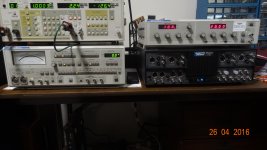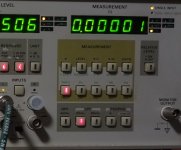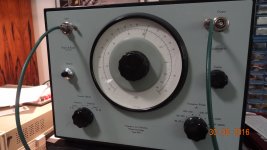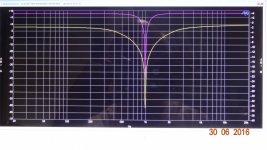Please follow the technical discussion or ask questions.Sorry, an additional resistive force on an electrodynamic speaker may have effect on the FR but that does not at all apply here.
As mentioned before, just changing the magnet for a stronger one will cause no additional effect on the FR only on the gain, same for a higher charge on the membrane, higher gain but same FR.
PID loops, instability etc have nothing to do with a possible AC dependency that we are discussing, so we are turning in circles around the real issue IMHO.
Yes, you can’t charge the membrane through the 47nF cap that’s in series with the 10Meg.
Hans
The PID loop and instability I mention are a result of the frequency response of the system changing due to the change in the spring constant of the drive. The motor frequency characteristics are determined by the magnetic force spring constant and rotor inertial momentum. When looking at the bode plot of the physical system, the time constant changes when the motor is loaded. As a result, the amplitude and phase response changes.
So don't go off on a tangent saying PID's have nothing to do with speakers as I never said that. I point out a real life, in the trenches, engineering analysis on how a physical system response changes in both amplitude vs frequency as well as phase vs frequency as a result of drive force changes. With my PID systems, it means compromise the tuning, or go adaptive.
And of course you can't charge the membrane through the cap, the neon is the charge path.
But the 10 megohm is the current limit. Without the ten Meg, a short will toast the neon first, then the cap across it.
With any leakage at the load, the neon will form a relaxation oscillator.
So far, two people have reported a sensitivity of sound vs DC voltage on ESL's, despite protests to the contrary. It should be measurable if real, no?
I'm interested in that.
Jn
Last edited:
The Technics' look pretty conventional, unlike the patent?
Hi Chris,
SB-7000a cross-over is an exact transfer from the patent [patent’s Fig. 1(1st embodiment), Fig.2(tweeter), Fig.3(woofer), Fig.4(mid)].
SB-7070 cross-over is patent’s Fig. 12(3rd embodiment) but all slopes are 12dB/oct
ps: the other guy might have been Samuel Groner
I wish he was involved into cross-overs as well but I haven’t found any connecting link. If you have any info please share it with us 🙂
George
Thanks for your input.Doesn't it have something to do with the membrane's mechanical characteristics (tension) changing in response to different polarizing voltage? After all, Quad membranes are made from elastic material.
My Stax Lambda Pros do sound different (to me) when fed from lower bias non Pro socket on SRM-T1 unit. Also, there have been reports from large diaphragm capacitor microphone users that sound of the mic changes when polarising voltage is changed from recommended value.
Tension on the membrane is not effected by the HV voltage, only the charge on the membrane changes.
And more charge means a higher gain for the system.
I can’t talk for other systems, but with the ESL63 push pull set up, I fail to see how the FR could change, but I don’t want to exclude it either.
And the point in this case is, does the roll off frequency goes up with a higher AC mains voltage ?
Hans
So am I, and that’s exactly why I started this in the first place.So far, two people have reported a sensitivity of sound vs DC voltage on ESL's, despite protests to the contrary. It should be measurable if real, no?
I'm interested in that.
Jn
But that seems the only point where we have the same opinion.
You simply don’t want to compare the strength of the magnetic field working on a voice coil to the charge on the ESL63 membrane, that’s for me as far as comparing can go.
For the rest comparing the two completely different systems is apples to pears.
Better would be to concentrate on the ESL only just to prevent this sort of confusion.
Hans
Hope you haven't forgotten: Jakob recently pointed out that published hearing thresholds are not intended to be limits of any kind.
Which raises the question that Jakob(x), yourself, and all proponents of the Golden Ear concept are dancing around: when designing a sensory test to figure out an audibility threshold, what is the hypothesis to be verified by the test? For the sake of an example, assume the threshold is 0.01% 3rd harmonic distortion @ 1KHz, and nothing ele.
- To find out if a subject that could reliably hear the distortion exists?
- To find out if a certain percentage of a random population sample can (or can not) reliably hear this level of distortion?
- To find out what percentage of a random population can reliably hear this level of distortion?
Each of these are different experiments/tests with different requirements and different complexity.
What Jakob(x) (and others) are doing to spread their usual FUD is rather simple but insidious: for example they take an experiment of the second type above, that returned a statistically null result and they start grumbling: a) "yes, but the null result doesn't mean nobody can hear those distortions", or b) "yes, but one subject out of 100 could got 16 out of 20 hits, so this invalidates the test null conclusion", etc...
All these are observation are apparently valid, but they are in the background either irrelevant or straight wrong observation (I was about to write full of four asterisks, but I corrected myself). a) was never in the scope of the test; if one wants an answer about a new hypothesis, he better design and execute a test to answer this (if he can afford to, that's not my problem), and b) the observation is invalid, since the probability to get a random result of 16/20 increases with the sample size, this having no relevance to the final null result, since others could hit a random result of 4/20 (which is, taken in isolation, an as much remarkable result as 16/20).
Etc... etc... etc... And when every argument fails or is dismantled, fall back to the immutable stance of "there is not enough money to put into research, so you have to trust my experience".
There's more here than could be put in a few sentences, but I guess everybody got the drift.
Last edited:
There's more here than could be put in a few sentences, but I guess everybody got the drift.
Fair remarks, thank you.
From the perspectives of some of the people frequently maligned around here, many of us start from the position that we hear things that are not imaginary and that are demonstrably affected (to people that listen carefully) by audio equipment design choices, including in equipment that measures very well as shown by AP tests.
Whether we here what we do because of trained listening, inadequate AP measurement protocols, real world combinations of equipment under non-laboratory conditions, some factor not listed, or some some combination of the above, we don't claim to know.
If you want a guess, it would be 'some combination of the above.' Trained listening does seem to help, as one factor.
We don't offer proof, or scientific evidence of our claims because it is hard, expensive, and time-consuming to do good quality human subject testing.
Much simpler for the people with APs to say, 'the machine doesn't show anything we know should result in claims of imperfection,' or similar.
The strange thing from a scientific perspective is that the second group above, the group with the APs, has some members that believe that the machine shows anything and everything that can be audible to any human on earth. Therefore, they jump to conclusions that all people in first group are mistaken or up to no good. Furthermore, some plainly admit they hate people that are up to no good, so they hate a number of people in the first group. The second group also thinks of themselves as being scientific, 'objectivist' they call it.
The so-called objectivists don't seem very objective or scientific to the first group above.
Last edited:
Well who other than Jan and Wayne have AP on here? JC used to have one ISTR not sure if he still does.
Well who other than Jan and Wayne have AP on here? JC used to have one ISTR not sure if he still does.
<raising fingers> Not an AP but a Rohde & Schwarz with the low distortion trimming and digital I/O. Slightly better than an advanced AP System 2 with options, mine is -127dB @1KHz and 20KHz bandwidth, no extra filters. Goes down to -130dB with the 400Hz HP filter on., spectrum analysis (included in the instrument) shows only 2nd harmonic popping out of the noise floor.
I use a Stanford Research SR-1 for serious measurements, an HP339 with an HP3563 to get an FFT for daily work. Used it just today!
<snip>
Once again, you miss an elementary fact (which belongs mostly to the sanity of the thinking processes): If the AP (or whatever) instruments shows nothing, and the reported empirical observations don't fit in the existing body of knowledge, then it's the reporter duty to provide proof of existence and an explanation of the alleged new phenomena.
Until these are provided, the community can safely ignore the reported observations; qualifying them as sensory illusions (in our case) may not be "nice" but is perfectly justified. The scientific community, as professionals, don't use a colorful language to dismiss, but rather simply ignore such observations, since the risk of "contamination" is minimal.
This is how science is working at least since Archimedes and the grounds why alchemy and the spontaneous generation theory (that is, dirty rags and cheese give birth to mice) didn't end up in the mainstream science.
You must understand the technical points a little clearer.So am I, and that’s exactly why I started this in the first place.
But that seems the only point where we have the same opinion.
You simply don’t want to compare the strength of the magnetic field working on a voice coil to the charge on the ESL63 membrane, that’s for me as far as comparing can go.
For the rest comparing the two completely different systems is apples to pears.
Better would be to concentrate on the ESL only just to prevent this sort of confusion.
Hans
I pointed out the difficulties inherent in a physical system caused by a never before considered aspect of the drive system, that of a change in the system's response due to actuation force.
All normal motion systems with a drivetrain are at the very least, a fourth order low pass. Taking the endpoint (output) as the feedback point requires making sure you are below unity gain before the output phase goes past 180 degrees phase shift. A fourth order will go well past that shift at some point.
My discussion was to detail how the fourth order filter I work with changes it's response physically based on output force,and discussed how an E drive may also change it's frequency response as the HV changes value.
I am not mixing fruit, I am explaining a physical model in electrical modeling terms that most here will understand.
Understand the technical aspects of what I describe, and move on to actual ESL testing.
Jn
...fit in the existing body of knowledge...
When it comes to human perception of audio equipment distortion, there is largely no valid existing body of knowledge because it would amount to medical research and Why Most Published Research Findings Are False ....(especially when conducted by engineers).
Moreover, there is no claim of any new phenomena it has been ignored since forever, much like the anomalies of economics theory as thoroughly described by Richard Thaler.
Last edited:
When it comes to human perception of audio equipment distortion, there is largely no valid existing body of knowledge because it would amount to medical research and Why Most Published Research Findings Are False ....(especially when conducted by engineers).
Moreover, there is no claim of any new phenomena it has been ignored since forever, much like the anomalies of economics theory as thoroughly described by Richard Thaler.
I guess you missed my point entirely. I would love to believe it’s because I did not make it clear, unfortunately it looks more like it’s in your vested interest to play dumb. Can’t wait for Jakob(x) to wake up and start yet another intentionally distorted and incomprehensible diversion on this subject, AKA “word salad”.
If you want to fight the right battle, there’s a place called arxiv.org that is happy to accommodate from Nobel prize candidates preprints to pataphysics. Write your observations and upload them, it’s an environment where nobody is suspicioned of any hidden agenda, and see what kind of feedback you’ll get. Don’t be surprised if it’s zero, zip, nada, jack ****. Feedback and comments are for those that are showing at least some respect for the principles of true scientific research.
Last edited by a moderator:
Some of my gear for distortion tests... plus an FFT on the analyzer monitor port (QA401). ShibaSoku 725D, AP 2722 with IM opt, Panasonic VP 7722, HP 339. with misc ultra low distortion sources.


I use the lowest ditortion speakers I can find to help in analysis .. less masking from high speaker distortion.
I listen only for a delta; A just detectable change in my system when learning how low distortion i can hear. By controlling the signal source distortion level and harmonic (2H or 3H), I determined that I can detect reliably to about .05% thd with loudspeaker (vs headphone). Below 0.1% things start to fad out when listening at a comfortable listening level.
So, if the amplifier, for example, is designed to never exceed 5-10 times lower, we are sure No One could hear it. Maybe with headphone (lower background spl) and higher spl level and very low distortion headphone (ESL?) maybe I could detect a just noticable change at lower level?
Or some one else could. So .005% or lower is my goal for design.
Obviously, the speaker distortion is a major limiting factor in what is a just detectable change ... Not our ears. Its why I would like to see everyone have better speaker drivers developed at a cost everyone could afford.
Each person can do this and learn where their own Just Detectable change threshold is for the system/speakers they have.
Having said that, there are other factors which determine difference detectability than harmonic level. Output impedance interfacing affects, for one example. Susceptibility to HF and EMI/RFI, PSRR, jitter etc.
THx-RNMarsh


I use the lowest ditortion speakers I can find to help in analysis .. less masking from high speaker distortion.
I listen only for a delta; A just detectable change in my system when learning how low distortion i can hear. By controlling the signal source distortion level and harmonic (2H or 3H), I determined that I can detect reliably to about .05% thd with loudspeaker (vs headphone). Below 0.1% things start to fad out when listening at a comfortable listening level.
So, if the amplifier, for example, is designed to never exceed 5-10 times lower, we are sure No One could hear it. Maybe with headphone (lower background spl) and higher spl level and very low distortion headphone (ESL?) maybe I could detect a just noticable change at lower level?
Or some one else could. So .005% or lower is my goal for design.
Obviously, the speaker distortion is a major limiting factor in what is a just detectable change ... Not our ears. Its why I would like to see everyone have better speaker drivers developed at a cost everyone could afford.
Each person can do this and learn where their own Just Detectable change threshold is for the system/speakers they have.
Having said that, there are other factors which determine difference detectability than harmonic level. Output impedance interfacing affects, for one example. Susceptibility to HF and EMI/RFI, PSRR, jitter etc.
THx-RNMarsh
Last edited:
I used to have two Sound Technology 1700 series, but gave one away:
retro vintage modern hi-fi: Sound Technology Stereo Test Gear In For Repair
My building partner Iain got it and associated gear up and tap dancing in a remarkably short time. These old guys, a 1700B and a 1701A, read down to about .002% looped on a good day with a tailwind, but can be (and his will be) a decent front end for connection to a laptop.
All good fortune,
Chris
retro vintage modern hi-fi: Sound Technology Stereo Test Gear In For Repair
My building partner Iain got it and associated gear up and tap dancing in a remarkably short time. These old guys, a 1700B and a 1701A, read down to about .002% looped on a good day with a tailwind, but can be (and his will be) a decent front end for connection to a laptop.
All good fortune,
Chris
Last edited:
My building partner Iain got it and associated gear up and tap dancing in a remarkably short time. These old guys, a 1700B and a 1701A, read down to about .002% looped on a good day with a tailwind, but can be (and his will be) a decent front end for connection to a laptop.
I used one of these with an external L/C filter on the source (yes, ironically 600 Ohms). The L's were all on wooden formers, didn't check for corrosion on the magnet wire, to get -140dB or so before there was an AP.
I used this.. a variable freq passive twin-T notch filter.. added active circuit to it.. switchable.
Allowed me to notch out a particular harmonic -- 2H or 3H. Or adj an ultra low distortion oscillator to have only one remaining harmonic (2H or 3H) and notch it out to below noise level. Essentially a source with zero measurable harmonics.


🙂
THx-RNMarsh
Allowed me to notch out a particular harmonic -- 2H or 3H. Or adj an ultra low distortion oscillator to have only one remaining harmonic (2H or 3H) and notch it out to below noise level. Essentially a source with zero measurable harmonics.


🙂
THx-RNMarsh
Last edited:
Understand the technical aspects of what I describe, and move on to actual ESL testing.
Jn
FWIW in testing electrostatic actuators for microphones I don't see a difference with bias voltage. This is an outlier since these are single ended with a predictable 1.3 % THD. I may try changing the supply on a Quad 63 but I have not seen significant effects from changing the bias voltage. Also a change can take minutes to propagate across the diaphragm.
The neon light is a useful troubleshooting device. if its flashing at all there are problems.
None of the ESL's I have seen or worked with are designed for maintenance or service. My experience is that anything with at least 5 KV exposed will sooner or later have problems. Most ESL's are quite labor intensive to service and making sure the dust is out is something of an afterthought.
Also on the 63, the dust covers are significantly thinner than the diaphragms. On the mods we used to do we change the dust covers out with 1/2 micron thick film (19 microinch). Its works well but is really fragile. The supply of film went up in smoke in the Paradise fire.
- Status
- Not open for further replies.
- Home
- Member Areas
- The Lounge
- John Curl's Blowtorch preamplifier part IV